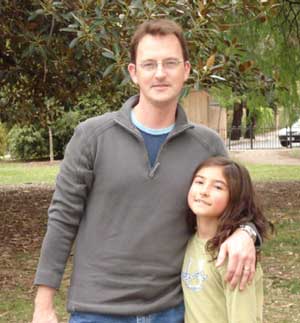Dr. Charles M. Higgins
The PhysOrg article Researchers Create Robot Driven by Moth’s Brain said
“In a notion taken from science fiction aficionados, University of Arizona researchers presented a robot that moves by using the brain impulses of a moth at the 37th annual Society for Neuroscience meeting in San Diego.Charles M. Higgins, UA associate professor of electrical and computer engineering, and doctoral student Timothy Melano presented their findings and outlined the mechanics behind the robot’s movements.
The robot’s motion is guided by a tiny electrode implanted in the moth’s brain, Higgins said, specifically to a single neuron that is responsible for keeping the moth’s vision steady during flight. The neuron transmits electrical signals which are then amplified in the robot’s base and through a mathematical formula, a computer translates the signals into action, making the robot move.”
Charles M. Higgins, Ph.D. is Associate Professor of Electrical Engineering and Neurobiology, Neuromorphic Vision and Robotic Systems Lab, The University of Arizona.
Chuck works in the field of Neuromorphic Engineering, in which insight from neurobiology is used as inspiration for engineering VLSI designs. He is broadly interested in autonomous robotics, and specifically in compact, robust, low-power vision sensors and motor control systems in hybrid analog/digital VLSI. His past projects have included real-time VLSI systems for processing visual motion, stereoscopic disparity, and egomotion. He is involved in projects ranging from hardware implementations of low-level elementary motion sensors to visual navigation system integration on small autonomous mobile robots.
He is also strongly interested in neuroscience, partly as an inspiration for engineering systems, and partly as a standalone scientific interest. His areas of neuroscience interest include learning, consciousness, cortical oscillations, synchronous firing, and mechanisms of higher-level biological motion and disparity processing.
Chuck coauthored Winner-Take-All-Based Visual Motion Sensors, The Neuronal Basis of Direction Selectivity in Lobula Plate Tangential Cells, Contrast Saturation in a Neuronally-Based Model of Elementary Motion Detection, Non-directional motion may underlie insect behavioral use of image speed, A Biomimetic Focal Plane Speed Computation Architecture, A Navigation Aid for the Blind Using Tactile-Visual Sensory Substitution, and A Biomimetic VLSI Architecture for Small Target Tracking. Read the full list of his publications!
Chuck earned a BS in Electrical/Computer Engineering from Louisiana State University in 1987, a MS in Electrical/Computer Engineering from Georgia Institute of Technology, and a PhD in Electrical/Computer Engineering from California Institute of Technology in 1993. He invented the patent Adaptive routing in a parallel computing system.
